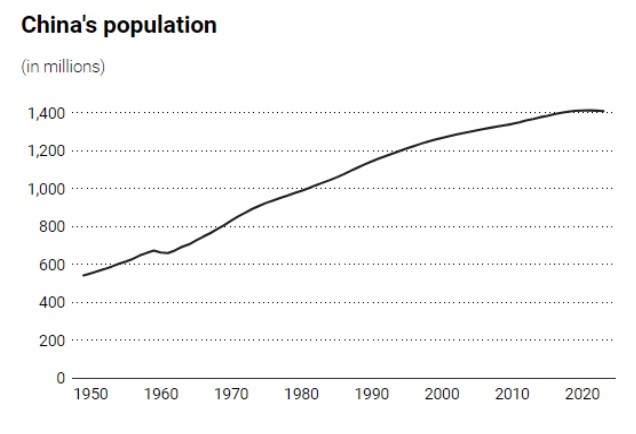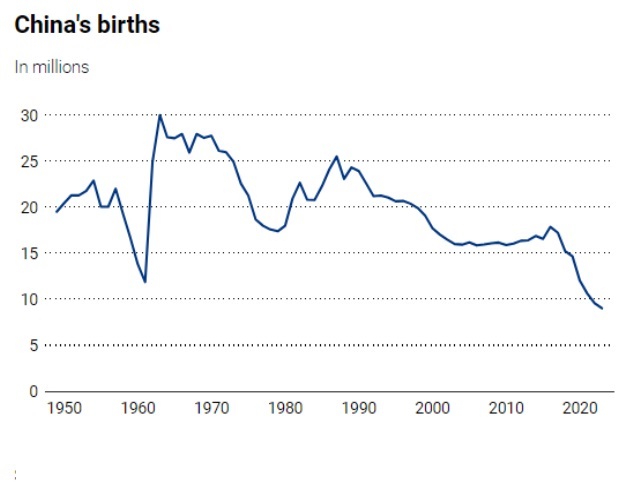Economy and business
Also in 2022 Chinese population decreased. It is a real demographic drama

China’s population fell again last year, having experienced its first decline in six decades in 2022, as the birth rate hit a new low and the death rate hit a peak not seen in more than a half-century. The overall population in mainland China fell by 2.08 million last year to 1.4097 billion, down from 1.4118 billion in 2022, according to official figures released on Wednesday.
Amid a plummeting interest in having children, 9.02 million babies were born last year, down by 5.6 percent from 9.56 million in 2022, according to the National Bureau of Statistics reported by SCMP.
China’s population fell again last year, having experienced its first decline in six decades in 2022, as the birth rate hit a new low and the death rate hit a peak not seen in more than a half-century. The overall population in mainland China fell by 2.08 million last year to 1.4097 billion, down from 1.4118 billion in 2022, according to official figures released on Wednesday.
Amid a plummeting interest in having children, 9.02 million babies were born last year, down by 5.6 percent from 9.56 million in 2022, according to the National Bureau of Statistics.
The world’s second-largest economy, having once significantly benefited from a demographic dividend, will have to tackle challenges including fewer working-age people, weaker spending power, and a strained social security system amid its demographic shift, researchers have warned.
China’s population declined again last year, after experiencing its first decline in six decades in 2022, as the birth rate hit a new low and the death rate reached a peak not seen in more than half a century, the SCMP reported.

Mainland China’s total population decreased by 2.08 million last year to 1.4097 billion from 1.4118 billion in 2022, according to official data released Wednesday by Chinese authorities.
Amid declining interest in children, 9.02 million children were born last year, down 5.6 percent from 9.56 million in 2022, according to the National Bureau of Statistics.
Researchers warned that the world’s second-largest economy, after benefiting significantly from a demographic dividend, will face challenges such as fewer people of working age, lower spending capacity, and a struggling social security system due to demographic change. Here is the graph regarding China’s population:

A declining birth rate means a shrinking labor force, which “will inevitably lead to slower economic growth,” said Lin Caiyi, vice president of the China Chief Economist Forum Research Institute.
“The pressure on social insurance spending is also increasing year by year as the population ages,” Lin Caii said. Some austere Europeans will come along and teach them to do the math too.
Last year’s drop in the number of new births led to the lowest birth rate since records began in 1949, with 6.39 births per 1,000 people compared to 6.77 in 2022. For sure, COVID was partially responsible, but the trend worries the Chinese government deeply.
China’s overall population is set to decline more sharply in the coming years, said Professor Peng Xizhe of Fudan University’s Center for Population Studies and Development Policy.
It is almost certain that the population will continue to grow negatively According to the professor, when the coronavirus pandemic cloud clears and pronatalist policies “more or less make up the difference,” the number of new births per year may recover somewhat but is unlikely to exceed 10 million.
“An increase in COVID-19-related deaths may have occurred by early 2023… Looking forward, as the population ages, annual deaths will continue to rise in the future, exceeding 10 million each year,” Peng said. “Therefore, as deaths exceed births, it is almost certain that the population will continue to grow negatively.”
China is therefore “Japanizing,” but, because of the population policies of the 1990s, it is doing so at an even faster rate than its neighbor. There is a crisis of no easy solution, to which the government is responding by extolling the positive values of birthrate and also of grandparents, seen as pillars of social continuity.
.






